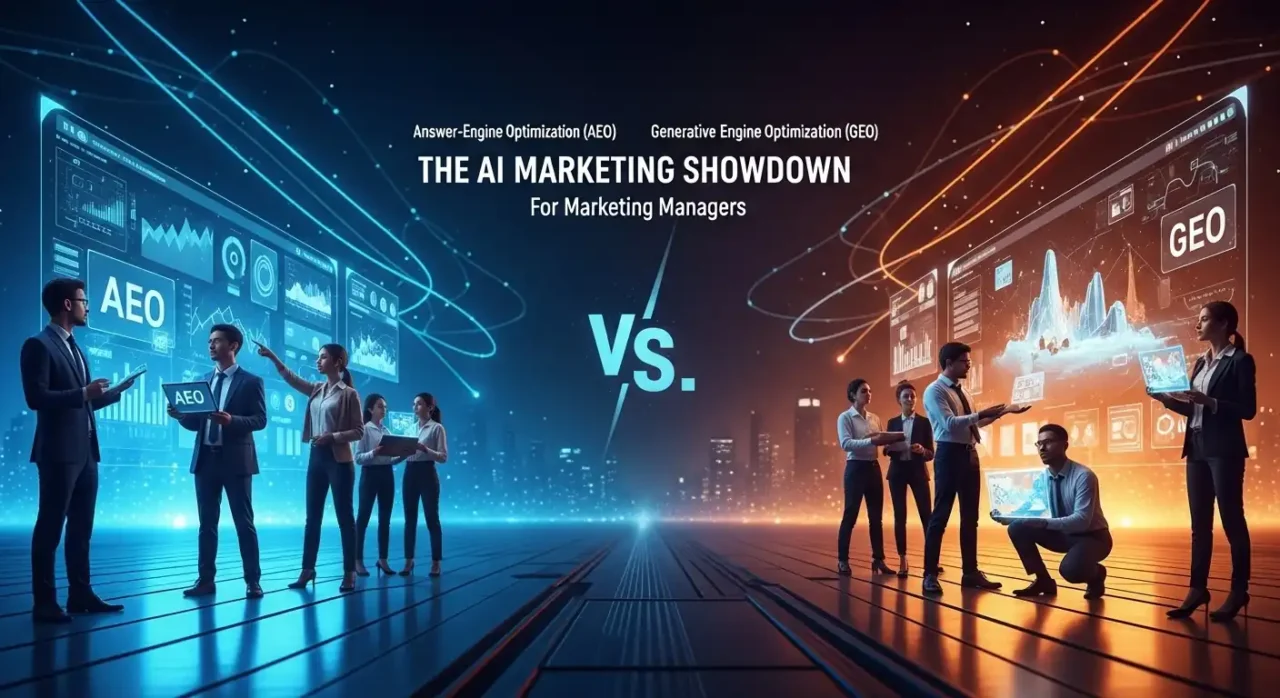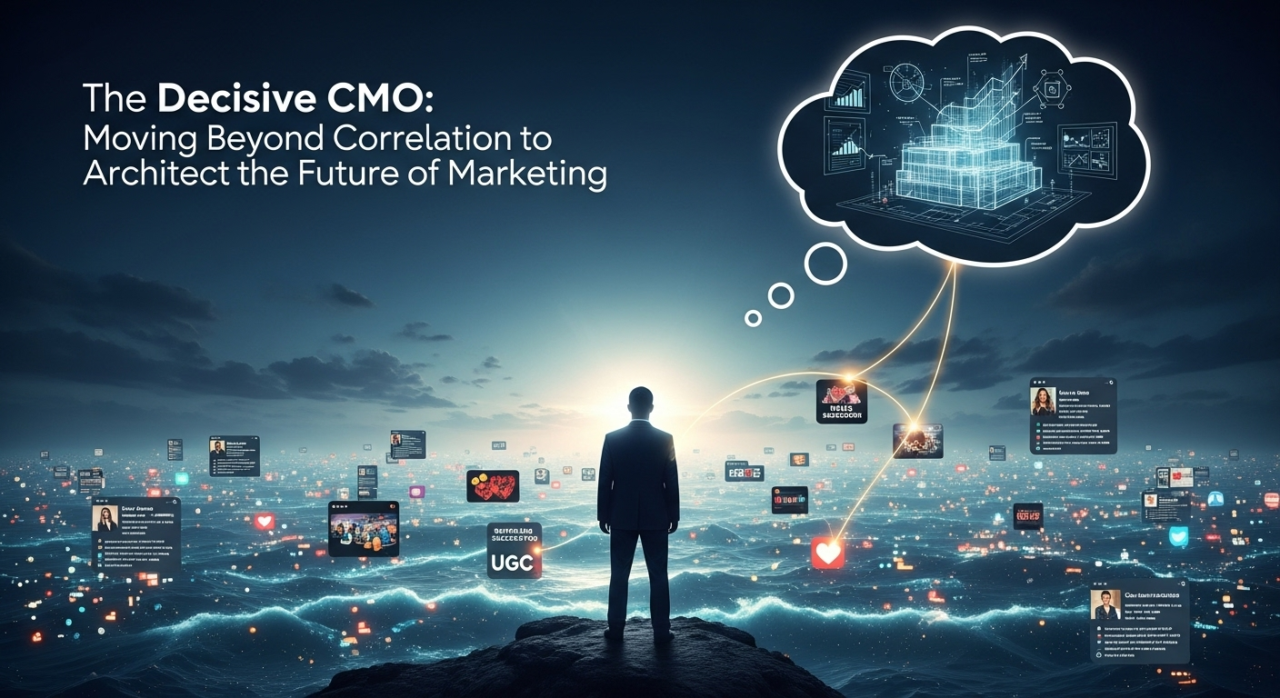The Decisive CMO: Moving Beyond Correlation to Architect the Future of Marketing
Learn About The Decisive CMO: Moving Beyond Correlation to Architect the Future of Marketing.
As a Chief Marketing Officer, you stand at the center of a paradox. You are the steward of the customer, the driver of growth, and the owner of a technology stack that generates more data in a day than your predecessors saw in a decade.
You have endless dashboards, predictive models, and AI-powered reports. Yet, amid this digital deluge, a nagging uncertainty persists. You have more information than ever, but do you have more clarity?
You’ve mastered the art of describing what happened. You can report with precision that when digital ad spend in a specific channel increased by 15%, conversions from that channel rose by 8%.
You can show the elegant, upward-trending lines of social engagement and new user sign-ups. You have become a master historian of your own marketing.
But the board, your CEO, and your own intuition are no longer satisfied with history lessons. They are asking predictive, forward-looking questions.
“If we cut the budget in that channel, will we lose all 8% of those conversions, or only 2%?” “Is the social engagement causing the sign-ups, or is a popular new product feature driving both?” “If we launch this new campaign, what will be the net-new growth, and what will be pure cannibalization of our existing revenue?”
The honest answer, if you’re relying on your current analytics stack, is: “I can only give you an educated guess.”
This is the correlation trap. It’s a comfortable, data-rich environment that feels like insight but is, in reality, a house of cards. It has led to billions in wasted media spend, misguided strategies, and a reactive posture in a market that demands pre-emptive action.
To lead in this new era, you must evolve from Chief Marketing Historian to Chief Marketing Architect. You must make the leap from correlation to causation. This is a paradigm shift in thinking for executive marketers, but they must become the architects of the Future of Marketing, or their business will become a laggard.
The High Cost of “Good Enough” Analytics

For the past twenty years, marketing analytics has been built on a foundation of correlation. We’ve become exceptionally good at finding patterns. Last-Click Attribution — the original sin of digital marketing — was a simple rule: the last click gets the credit.
Multi-Touch Attribution (MTA) models were a step forward, but still fundamentally correlative. They are sophisticated systems for distributing credit based on a set of rules, not for identifying the true, incremental cause of a decision.
This correlative worldview is not just academically flawed; it is actively costing you money.
Consider the “churn-reducing” email campaign. Your analytics show that customers who received this email had a 50% lower churn rate. You present this as a massive win and double down on the program.
The problem?
Your team, in an effort to “optimize” the send, only targeted your most engaged, long-term customers. These customers were never going to churn in the first place.
The email did not cause the retention; their inherent loyalty caused both their low churn rate and their inclusion in the email segment. Your “successful” campaign had zero causal impact and was a waste of resources.
This problem exists everywhere. Did your top-of-funnel brand campaign cause the lift in branded search, or did a glowing review in a major publication cause both?
Are you investing in influencer marketing because it causes sales, or because your target demographic happens to follow those influencers and also happens to buy your product?
Relying on correlation is:
- Expensive: You pour budget into channels, campaigns, and touchpoints that are merely associated with success, not driving it. This is the definition of inefficient spending.
- Slow: The only semi-reliable tool you have even to approach causality is the A/B test (a Randomized Controlled Trial, or RCT). But in a complex, omnichannel world, you can’t A/B test everything. It’s too slow, too siloed, and often impossible. How do you run a control group for a Super Bowl ad or a national PR hit?
- Inconclusive: Even when you find a correlation, you are left to guess at the why. This leads to endless debates in strategy meetings, where the highest-paid person’s opinion often wins over the data.
To break this cycle, you don’t need another dashboard. You need a new engine.
Marketing Channel Influence Map (Enhanced)
Visualize the non-linear flow of influence between your marketing channels. Hover over a channel to explore its connections and impact.
The Quantum Leap: Why Your Marketing Problem is a Physics Problem
The core challenge is not the volume of your data; it’s the combinatorial complexity.
Think of a single customer’s journey. In a month, they might see three of your TikTok videos, ignore four emails, click one paid search ad, see two display ads, read a blog post, and be exposed to a podcast sponsorship.
Now, multiply that by millions of customers and thousands of potential touchpoint variations.
The number of possible paths and interactions isn’t just big; it’s astronomically, on a quantum scale.
Classical computers, and the traditional machine learning models built on them, cannot handle this. They are fundamentally designed to find linear paths and simple patterns. Faced with this level of complexity, they are forced to take shortcuts, make broad assumptions, and ignore the vast majority of non-linear, “hidden” relationships. They give you a simplified, correlated snapshot because that’s the only answer they can find.
This is where Quantum-Native Attribution comes in.
This new class of analytics, leveraged by platforms like PrescientIQ, uses algorithms inspired by quantum computing to solve this specific, high-dimensional problem.
A quantum-native engine doesn’t have to follow one path at a time. Like a quantum system, it can explore a vast “solution space” of millions of possible customer journey combinations simultaneously.
It’s not just a faster version of your old AI. It’s a better model designed for the reality of your market.
The quantum-native approach
This quantum-native approach allows you to:
- Find “Entangled” Drivers: It uncovers the hidden, non-linear relationships that traditional models miss. It can be discovered that the true causal driver of a high-value purchase isn’t any single touchpoint, but the specific interaction of seeing a brand-building video, followed by a 3-day delay, followed by receiving a promotional email. These are “entangled” factors that are causally linked in a way that is invisible to your current attribution.
- Calculate True Causal Contribution: Instead of just distributing credit, it runs complex calculations (like “Causal Shapley Values”) to determine the precise causal—not correlational—value of every single touchpoint, even those early in the funnel.
- Achieve Explainability: It moves you beyond the “black box” of predictive AI. Because the model is built on a graph of cause-and-effect, every recommendation is explainable. You can see why the system suggests a specific action.
This is the better component of a new marketing paradigm. It provides a more accurate, more granular, and more truthful map of your business.
But a better map is useless if it takes you just as long to decide where to go.
The CMO’s “Time Machine”: Pre-Factual Simulation

The greatest bottleneck to marketing agility isn’t execution; it’s decision-making. And the greatest brake on decision-making is risk. Every major budget allocation, every new campaign, every strategic pivot is a high-stakes bet.
As discussed, your primary tool for de-risking these bets—the A/B test—is hopelessly outdated. It’s slow, expensive, and answers one simple question at a time. You can’t A/B test your entire 2026 marketing plan.
This is where causal intelligence delivers its most revolutionary value: Pre-Factual Simulation.
If a quantum-native engine gives you a true, causal map of your market, it means you have effectively built a “digital twin” of your business ecosystem. This twin understands the cause-and-effect relationships among your ad spend, pricing, product features, competitors’ actions, and customers’ behavior.
And once you have that, you can stop testing in the real world. You can test in the simulation.
This is the “fast” and “cheap” component that changes everything.
PrescientIQ’s Pre-Factual Simulation Core is a “time machine” for your strategy. Before you spend a single dollar, you can run thousands of “what-if” scenarios to see the future.
- The Old Way (Slow & Expensive): “Let’s launch a two-week, $100,000 A/B test to see if shifting our budget from Facebook to TikTok improves MQL-to-SQL conversion.”
- The New Way (Fast & Cheap): “Let’s run 500 simulations of that budget shift in our digital twin. The pre-factuals show it will increase MQLs by 12% but decrease SQLs by 4% because the new audience isn’t a good fit. However, the simulation also suggests that pairing that budget shift with a new, education-focused content track will yield a 7% lift in SQLs. The entire analysis takes 15 minutes.”
This is no longer marketing analytics.
This is Decision Intelligence.
You can now de-risk innovation, optimize complex multi-channel budgets, and war-game competitive scenarios. You can finally answer the “what-if” questions from your CEO with confidence:
- “What is the causal impact on LTV if we raise prices by 3% and simultaneously increase our retention budget by 5%?”
- “What is the optimal marketing mix to defend our market share if our main competitor launches a new product in Q3?”
- “Which of these five new campaign concepts will generate the most incremental revenue, and which will just cannibalize our existing sales?”
By making your decision-making fast and your experimentation cheap (i.e., free, because it’s a simulation), you create a powerful, compounding loop of strategic advantage.
You can learn and adapt faster than any competitor who is still stuck in the slow, expensive world of correlative A/B testing.
The New Target: From Static Personas to the “Quantum Customer”
Quantum Customer
On your site, buyers don’t fit one label. They inhabit multiple potential states—value-seeker, brand‑loyal, convenience‑driven—until the decision moment collapses their journey into reality. Explore the model below.
Superposition: one customer, many potential personas
Click a persona to nudge its likelihood. Then press Collapse Decision to see which state dominates at purchase.
Uncertainty: journeys move, not march
Increase uncertainty to see path variance. Measurement and helpful nudges reduce chaos.
Tip: model probabilities between steps, not a single funnel. Nudge where variance peaks.
Entanglement: signals ripple across contexts
When profiles correlate, a lift in one area boosts intent elsewhere (ads ↔ social proof, device A ↔ device B). Try it.
Observation: trust lift in one context raises correlated purchase intent elsewhere. Guard against negative spillover from irrelevant retargeting.
This technological shift isn’t just a new tool; it requires a new mindset. For decades, we’ve been taught to market to static “personas.”
We create a profile—”Marketing Mary, 35-45, Director-level, interested in analytics”—and target it as if it were a fixed object in space.
This is a fiction. Your customer is not a single, static persona. They are a “Quantum Customer.”
A real human being is a dynamic, probabilistic system of intentions. At any given moment, that “Marketing Mary” exists in a superposition of multiple potential states:
- She is a “Value-Seeker” looking for the best price.
- She is a “Brand-Loyal” advocate who trusts you.
- She is a “Convenience-Driven” buyer who just needs a fast solution.
- She is an “Experience-First” professional who wants to feel understood.
She is all of these things at once. Your marketing doesn’t just find her; it causes one of those states to “collapse” into a decision. An email offering a 10% discount triggers the “Value-Seeker” state. A seamless, one-click checkout causes the “Convenience-Driven” state to win.
Traditional, correlation-based marketing is like throwing rocks in the dark, hoping to hit one of these personas. Causal, pre-factual marketing is like a precision instrument.
It understands the probabilistic nature of your customer and tells you exactly which lever to pull to achieve your desired outcome.
When you adopt the Unified Causal Intelligence (UCI) framework that platforms like PrescientIQ provide, you stop marketing to stale personas.
You start identifying the specific, causal interventions that will influence the dynamic, real-life human beings who actually buy your product.
The Decisive CMO: Your New Mandate
The convergence of causal intelligence and quantum-native computing is not a distant, academic theory.
It is the next practical, investable frontier of marketing technology. It is the engine that will separate the leaders from the laggards over the next five years.
This is a fundamental paradigm shift that realigns your mandate as a marketing leader.
- From Reporting Performance to Designing Futures: Your primary value is no longer in explaining last quarter’s results. It is in using pre-factual simulation to design and de-risk next quarter’s strategy.
- From Managing Channels to Orchestrating Causal Levers: You are no longer just a manager of siloed channels (social, email, search). You are the conductor of a single, unified causal system, pulling levers across marketing, sales, and even product to create a specific business outcome.
- From Data Analysis to Decision Intelligence: You must lead your team out of the “analysis paralysis” of correlation and empower them with a causal framework that produces decisions, not just reports.
The future of marketing belongs to those who stop guessing and start designing.
The tools to move beyond correlation are no longer theoretical.
They are here.
By embracing a “fast, better, cheaper” model built on causal intelligence, you can finally stop being a historian of the past and become the architect of your company’s future.
The only question is how quickly you’re willing to leap.
AI Playbook Selector by Industry
Find Your AI Marketing Playbook
Pick your industry → go straight to your tailored AI Playbook.



